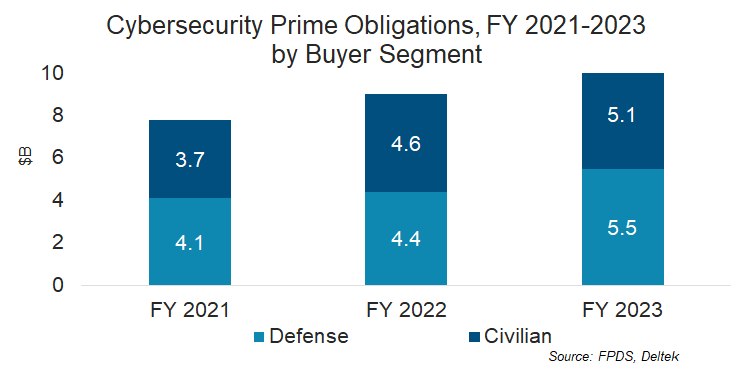FY 2021-2023 Federal Cybersecurity Prime Contract Spending
Published: November 15, 2024
Federal Market AnalysisCybersecurityForecasts and SpendingSpending Trends
Federal prime contract procurement of cybersecurity-related goods and services totaled over $27B from FY 2021 to 2023, increasing 36% over the three-year period.
Federal cybersecurity priorities and challenges continue to drive increases in contracted spending as departments and agencies seek out effective commercial solutions and supporting services. This continues to be evident in the procurement data posted to the Federal Procurement Data System (FPDS). Past obligations are an indicator of past contract spending trends and scale. They verify the strength and evolution of the market and Deltek uses this data set among several as we develop our cybersecurity market forecasts.
Analysis Methodology
To get a sense of the size and trajectory of federal contract spending for cybersecurity, Deltek searched over 3.9 million FPDS prime contract obligation transactions for FY 2021-2023, the three recent fiscal years for which we have the most settled and complete data. (Those familiar with agency FDPS data reporting will recall that the Department of Defense (DoD) lags in their reporting by up to 90 days, so data for FY 2024 is still fluid at this point.)
For the cybersecurity market, Deltek uses FPDS prime contract obligation transactions in the categories of Information Technology, Professional Services, Research and Development, Defense and Aerospace, and Operations and Maintenance. To narrow the pool of relevant prime contract dollars, we search the contract requirement description and contract names for each transaction for a selection of cybersecurity-related keywords and then further vet those transactions for relevance to the specific market.
Of those 3.9 million in transactions, Deltek identified nearly 41 thousand as cybersecurity-related. These transactions represent a conservative estimate of cybersecurity spending, acknowledging the potential for obligations that are not identifiable based on publicly available data.
This analysis provides an approximate baseline for cyber-related contract awards that can be used to assess the overall size and composition of federal spending. However, contract obligations are intended to provide a sense of spending scale and are not all-inclusive. Some contracts include embedded cyber spending but are not exclusively cyber.
Total Cybersecurity Spending from FY 2021 through FY 2023
In completing this analysis, we were able to identify more than $27B in cybersecurity-related prime contract obligations from FY 2021 to 2023. It is noteworthy that this contract spending continued a steady upward trend, increasing 36% over the three-year period.

Cybersecurity Spending by Buyer Segment
Digging a bit deeper into the data to determine how the dollars fall between Defense and Civilian departments and agencies provides a little more insight into the market. While the total spend increased from FY 2021 through FY 2023, the relative proportion of Defense and Civilian spending in FY 2021 and FY 2023 were about the same, but Civilian spending exceeded Defense sector cyber-spending in FY 2022. Many factors may contribute to these fluctuations, such as cyclicality and new program starts.

Small Business Cybersecurity Spending
Finally, a look at agency prime contract spending for cybersecurity with small businesses sheds light on a major acquisition policy priority for most agencies – increasing small business utilization. Between FY 2021 and FY 2023 agency total contract obligations with small business for cybersecurity grew by 32%. However, the relative proportion of obligations made with small businesses remained fairly steady, averaging about 41% over the three years and never diverging by more than 1% from that level.

To see further details of how FY 2021-2023 cyber-obligations shake out and to get our full perspective on the federal cybersecurity market, check out Deltek's report, Federal Cybersecurity Market, 2024-2028.